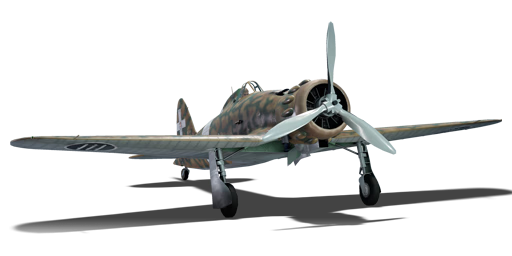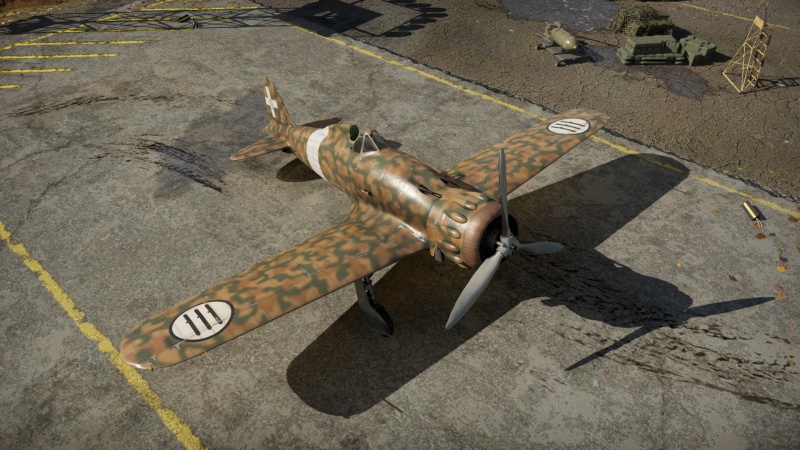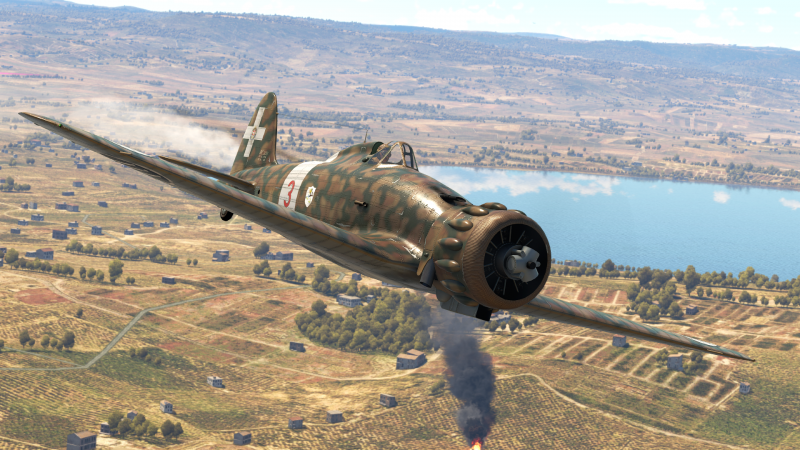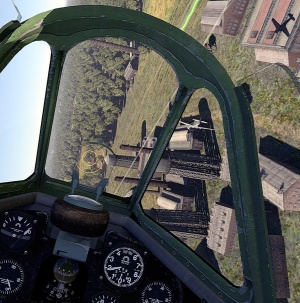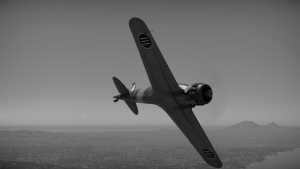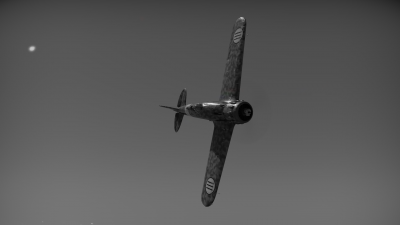Difference between revisions of "C. 200 serie 3"
(→History) (Tag: Visual edit) |
(Specs-Card ArtImage added.) |
||
| (18 intermediate revisions by 9 users not shown) | |||
| Line 1: | Line 1: | ||
| − | |||
{{About | {{About | ||
| about = Italian fighter '''{{PAGENAME}}''' | | about = Italian fighter '''{{PAGENAME}}''' | ||
| − | + | | usage = other versions | |
| − | | usage | + | | link = C. 200 (Family) |
| − | | link | + | }} |
| − | | | + | {{Specs-Card |
| − | | | + | |code=mc200_serie3_italy |
| + | |images={{Specs-Card-Image|GarageImage_{{PAGENAME}}.jpg|ArtImage_{{PAGENAME}}.png}} | ||
}} | }} | ||
== Description == | == Description == | ||
<!-- ''In the description, the first part should be about the history of and the creation and combat usage of the aircraft, as well as its key features. In the second part, tell the reader about the aircraft in the game. Insert a screenshot of the vehicle, so that if the novice player does not remember the vehicle by name, he will immediately understand what kind of vehicle the article is talking about.'' --> | <!-- ''In the description, the first part should be about the history of and the creation and combat usage of the aircraft, as well as its key features. In the second part, tell the reader about the aircraft in the game. Insert a screenshot of the vehicle, so that if the novice player does not remember the vehicle by name, he will immediately understand what kind of vehicle the article is talking about.'' --> | ||
| − | + | The '''{{Specs|name}}''' is a rank {{Specs|rank}} Italian fighter {{Battle-rating}}. It was introduced in [[Update 1.69 "Regia Aeronautica"]] along with the initial Italian aviation tree, but a variant existed in the [[C. 200 serie 3 (Germany)|German tech tree]] prior to the update. | |
| − | |||
| − | The '''{{Specs|name}}''' is a rank {{Specs|rank}} Italian fighter {{Battle-rating}}. It was introduced in [[Update 1.69 "Regia Aeronautica"]] along with the initial Italian aviation tree, but a variant existed in the [[C.200 serie 3 (Germany)|German tech tree]] prior to the update. | ||
The Macchi 200 is a standard fighter of the Italian tree. It is moderately armed for its rank, consisting of two 12.7 mm Breda-SAFAT machine guns firing through the propeller arcs. | The Macchi 200 is a standard fighter of the Italian tree. It is moderately armed for its rank, consisting of two 12.7 mm Breda-SAFAT machine guns firing through the propeller arcs. | ||
| Line 20: | Line 18: | ||
Furthermore, as of 1.55, its payload is not modelled, so it doesn't carry bombs, meaning it's a poor ground attacker, being only able to harm soft Ground targets. | Furthermore, as of 1.55, its payload is not modelled, so it doesn't carry bombs, meaning it's a poor ground attacker, being only able to harm soft Ground targets. | ||
| − | For the guns, the same applies to all other Italian aircraft, generally you want to use Tracers, Anti-air or Stealth since they are the belts that deal the most damage. They suffer above 300 | + | For the guns, the same applies to all other Italian aircraft, generally you want to use Tracers, Anti-air or Stealth since they are the belts that deal the most damage. They suffer above 300 m, so fire only at or below that range for the best effects. Furthermore, much like the other Italian fighters the armament is woefully inadequate to deal with bombers, hence it is best to avoid them entirely, or focus on taking out the engines. The only exceptions are the very early biplane bombers, such as [[Swordfish Mk I|Swordfish]], [[Po-2]] and the like. |
| − | [[File:FighterImage_MC200s7vsP36C.jpg|thumbnail|right|[[C.200 serie 7|M.C.200]] vs [[P-36C|P-36C ''Hawk'']] over industrial zone in Ruhr.]] | + | [[File:FighterImage_MC200s7vsP36C.jpg|thumbnail|right|[[C. 200 serie 7|M.C. 200]] vs [[P-36C|P-36C ''Hawk'']] over industrial zone in Ruhr.]] |
== General info == | == General info == | ||
| − | === Flight | + | === Flight performance === |
| − | ''Describe how the aircraft behaves in the air. Speed, manoeuvrability, acceleration and allowable loads - these are the most important characteristics of the vehicle.'' | + | {{Specs-Avia-Flight}} |
| + | <!-- ''Describe how the aircraft behaves in the air. Speed, manoeuvrability, acceleration and allowable loads - these are the most important characteristics of the vehicle.'' --> | ||
| − | {| class="wikitable" style="text-align:center" | + | {| class="wikitable" style="text-align:center" width="70%" |
| − | + | ! rowspan="2" | Characteristics | |
| − | |||
| − | |||
| − | ! | ||
| − | |||
! colspan="2" | Max Speed<br>(km/h at 4,500 m) | ! colspan="2" | Max Speed<br>(km/h at 4,500 m) | ||
| − | ! rowspan="2" | Max altitude<br>( | + | ! rowspan="2" | Max altitude<br>(metres) |
! colspan="2" | Turn time<br>(seconds) | ! colspan="2" | Turn time<br>(seconds) | ||
| − | ! colspan="2" | Rate of climb<br>( | + | ! colspan="2" | Rate of climb<br>(metres/second) |
| − | ! rowspan="2" | Take-off run<br>( | + | ! rowspan="2" | Take-off run<br>(metres) |
|- | |- | ||
| − | ! AB | + | ! AB !! RB !! AB !! RB !! AB !! RB |
| − | ! RB | ||
| − | ! AB | ||
| − | ! | ||
| − | |||
| − | ! RB | ||
| − | |||
| − | |||
| − | |||
| − | ! | ||
| − | |||
| − | ! | ||
| − | ! | ||
| − | ! | ||
| − | |||
| − | |||
|- | |- | ||
| − | ! | + | ! Stock |
| − | + | | 483 || 466 || rowspan="2" | {{Specs|ceiling}} || 16.2 || 17.6 || 15.0 || 15.0 || rowspan="2" | 280 | |
| − | |||
| − | |||
| − | |||
| − | |||
|- | |- | ||
| − | | | + | ! Upgraded |
| + | | 533 || 504 || 15.2 || 16.0 || 22.0 || 18.0 | ||
|- | |- | ||
|} | |} | ||
==== Details ==== | ==== Details ==== | ||
| − | {| class="wikitable" style="text-align:center" | + | {| class="wikitable" style="text-align:center" width="50%" |
|- | |- | ||
! colspan="5" | Features | ! colspan="5" | Features | ||
|- | |- | ||
| − | ! Combat flaps | + | ! Combat flaps !! Take-off flaps !! Landing flaps !! Air brakes !! Arrestor gear |
| − | ! Take-off flaps | ||
| − | ! Landing flaps | ||
| − | ! Air brakes | ||
| − | ! Arrestor gear | ||
|- | |- | ||
| ✓ || ✓ || ✓ || X || X <!-- ✓ --> | | ✓ || ✓ || ✓ || X || X <!-- ✓ --> | ||
| Line 82: | Line 55: | ||
|} | |} | ||
| − | {| class="wikitable" style="text-align:center" | + | {| class="wikitable" style="text-align:center" width="50%" |
|- | |- | ||
| − | ! colspan=" | + | ! colspan="7" | Limits |
|- | |- | ||
| − | ! rowspan="2" | | + | ! rowspan="2" | Wings (km/h) |
| − | ! rowspan="2" | Gear | + | ! rowspan="2" | Gear (km/h) |
| − | ! | + | ! colspan="3" | Flaps (km/h) |
! colspan="2" | Max Static G | ! colspan="2" | Max Static G | ||
|- | |- | ||
| − | ! + | + | ! Combat !! Take-off !! Landing !! + !! - |
| − | ! - | ||
|- | |- | ||
| − | | {{Specs|destruction| | + | | 845 <!-- {{Specs|destruction|body}} --> || {{Specs|destruction|gear}} || 535 || 450 || 260 || ~16 || ~7 |
|- | |- | ||
|} | |} | ||
| Line 100: | Line 72: | ||
{| class="wikitable" style="text-align:center" | {| class="wikitable" style="text-align:center" | ||
|- | |- | ||
| − | ! colspan="4" | Optimal velocities | + | ! colspan="4" | Optimal velocities (km/h) |
|- | |- | ||
| − | ! Ailerons | + | ! Ailerons !! Rudder !! Elevators !! Radiator |
| − | ! Rudder | ||
| − | ! Elevators | ||
| − | ! Radiator | ||
|- | |- | ||
| < 400 || < 270 || < 550 || > 300 | | < 400 || < 270 || < 550 || > 300 | ||
| Line 111: | Line 80: | ||
|} | |} | ||
| − | + | === Survivability and armour === | |
| − | + | {{Specs-Avia-Armour}} | |
| − | ! | + | <!-- ''Examine the survivability of the aircraft. Note how vulnerable the structure is and how secure the pilot is, whether the fuel tanks are armoured, etc. Describe the armour, if there is any, and also mention the vulnerability of other critical aircraft systems.'' --> |
| − | + | ||
| − | + | * No armour | |
| − | + | * Self-sealing fuel tanks (1 behind engine, 1 under the pilot) | |
| − | |||
| − | |||
| − | |||
| − | |||
| − | |||
| − | |||
| − | |||
| − | === | + | === Modifications and economy === |
| − | + | {{Specs-Economy}} | |
== Armaments == | == Armaments == | ||
| + | {{Specs-Avia-Armaments}} | ||
=== Offensive armament === | === Offensive armament === | ||
| + | {{Specs-Avia-Offensive}} | ||
<!-- ''Describe the offensive armament of the aircraft, if any. Describe how effective the cannons and machine guns are in a battle, and also what belts or drums are better to use. If there is no offensive weaponry, delete this subsection.'' --> | <!-- ''Describe the offensive armament of the aircraft, if any. Describe how effective the cannons and machine guns are in a battle, and also what belts or drums are better to use. If there is no offensive weaponry, delete this subsection.'' --> | ||
{{main|Breda-SAFAT (12.7 mm)}} | {{main|Breda-SAFAT (12.7 mm)}} | ||
| Line 138: | Line 102: | ||
== Usage in battles == | == Usage in battles == | ||
| − | <!-- ''Describe the tactics of playing in | + | <!-- ''Describe the tactics of playing in the aircraft, the features of using aircraft in a team and advice on tactics. Refrain from creating a "guide" - do not impose a single point of view, but instead, give the reader food for thought. Examine the most dangerous enemies and give recommendations on fighting them. If necessary, note the specifics of the game in different modes (AB, RB, SB).'' --> |
| − | + | The C. 200 serie 3 is a fighter aircraft exclusively made for the energy fighting style. With its excellent acceleration and climb rate, it will not be a problem to take off and gain altitude faster than your opponents. It is recommended to play it at medium-high altitude because without combat energy, this aircraft looks like a brick. Once you've gained enough altitude, jump on top of your enemies without fear of ripping a wing because this plane is capable of reaching 750 km/h before breaking up. When you have accumulated enough combat energy, you can challenge even the most manoeuvrable planes, but be careful not to run out before the end of the fight otherwise it will be very difficult to win. | |
| − | |||
| − | |||
=== Manual Engine Control === | === Manual Engine Control === | ||
| Line 154: | Line 116: | ||
! rowspan="2" | Turbocharger | ! rowspan="2" | Turbocharger | ||
|- | |- | ||
| − | ! Oil | + | ! Oil !! Water !! Type |
| − | ! Water | ||
| − | ! Type | ||
| − | |||
| − | |||
| − | |||
| − | |||
| − | |||
| − | |||
| − | |||
| − | |||
| − | |||
| − | |||
| − | |||
| − | |||
| − | |||
| − | |||
| − | |||
| − | |||
| − | |||
|- | |- | ||
| − | | | + | | Controllable || Controllable<br>Not auto controlled || Not controllable<br>Not auto controlled || Controllable<br>Not auto controlled || Separate || Not controllable<br>1 gear || Not controllable |
| − | | | ||
| − | | | ||
| − | | | ||
| − | | | ||
| − | | | ||
| − | | | ||
| − | | | ||
| − | | | ||
| − | | | ||
| − | | | ||
| − | | | ||
| − | |||
| − | |||
| − | |||
| − | |||
| − | | | ||
|- | |- | ||
|} | |} | ||
| Line 203: | Line 130: | ||
* Good rate of climb | * Good rate of climb | ||
* Decent energy retention | * Decent energy retention | ||
| − | * | + | * Sturdy construction |
* It has very good cockpit view, lack of canopy means superb view to the sides and above, while the slim head rest ensures a good view to the rear as well | * It has very good cockpit view, lack of canopy means superb view to the sides and above, while the slim head rest ensures a good view to the rear as well | ||
* Good control at most speeds | * Good control at most speeds | ||
| − | * Can | + | * Can engage into prolonged dives (very high wing rip speed) |
| − | '''Cons''' | + | '''Cons:''' |
* Acceleration leaves something to be desired | * Acceleration leaves something to be desired | ||
| − | * The guns aren't exceptional, low rate of fire and ineffective above 300 | + | * The guns aren't exceptional, low rate of fire and ineffective above 300 m. |
* Engine is prone to overheating | * Engine is prone to overheating | ||
* Its speed in level flight is nothing exceptional. | * Its speed in level flight is nothing exceptional. | ||
== History == | == History == | ||
| − | <!-- ''Describe the history of the creation and combat usage of the aircraft in more detail than in the introduction. If the historical reference turns out to be too long, take it to a separate article, taking a link to the article about the vehicle and adding a block "/ History" (example: <nowiki>https://wiki.warthunder.com/(Vehicle-name)/History</nowiki>) and add a link to it here using the <code>main</code> template. Be sure to reference text and sources by using <code><nowiki><ref></ref></nowiki></code>, as well as adding them at the end of the article with <code><nowiki><references /></nowiki></code>. This section may also include the vehicle's dev blog entry (if applicable) and the in-game encyclopedia description (under <code><nowiki>=== In-game description ===</nowiki></code>, also if applicable).'' --> | + | <!-- ''Describe the history of the creation and combat usage of the aircraft in more detail than in the introduction. If the historical reference turns out to be too long, take it to a separate article, taking a link to the article about the vehicle and adding a block "/History" (example: <nowiki>https://wiki.warthunder.com/(Vehicle-name)/History</nowiki>) and add a link to it here using the <code>main</code> template. Be sure to reference text and sources by using <code><nowiki><ref></ref></nowiki></code>, as well as adding them at the end of the article with <code><nowiki><references /></nowiki></code>. This section may also include the vehicle's dev blog entry (if applicable) and the in-game encyclopedia description (under <code><nowiki>=== In-game description ===</nowiki></code>, also if applicable).'' --> |
| − | The M.C.200 is a pre-war Italian monoplane manufactured by the Macchi aircraft company, its name is derived from its chief designer, Mario Castoldi, designer of the famous M.39 and M.C.72 racing planes. | + | The M.C. 200 is a pre-war Italian monoplane manufactured by the Macchi aircraft company, its name is derived from its chief designer, Mario Castoldi, designer of the famous M.39 and M.C.72 racing planes. |
| − | The M.C.200 was a design put forward for the Regia Aeronautica's Series 0 tender set in 1934, a specification for a modern mono-wing interceptor. Of the Italian aeronautical industry, three firms submitted a prototype, the G.50 by Fiat, the Re 2000 by Reggiane and the M.C 200 by Macchi. Of the three designs, the M.C 200 won the tender, being the fastest and most advanced aircraft, although it did have issues that needed fixing before it could enter service, most notable its issues with auto-rotation and sudden, violent stalls. For this reason, the [[G.50 serie 2|Fiat G.50]], while inferior to the M.C 200, was chosen for production as well, as it would be able to enter service on short notice, the G.50 went on and served in the Spanish civil war, and for a time, alongside the M.C.200, which started production a few months after its former competitor, in the summer of 1939. At the start of the war, 144 were in service. | + | The M.C. 200 was a design put forward for the Regia Aeronautica's Series 0 tender set in 1934, a specification for a modern mono-wing interceptor. Of the Italian aeronautical industry, three firms submitted a prototype, the G.50 by Fiat, the Re 2000 by Reggiane and the M.C 200 by Macchi. Of the three designs, the M.C 200 won the tender, being the fastest and most advanced aircraft, although it did have issues that needed fixing before it could enter service, most notable its issues with auto-rotation and sudden, violent stalls. For this reason, the [[G.50 serie 2|Fiat G.50]], while inferior to the M.C 200, was chosen for production as well, as it would be able to enter service on short notice, the G.50 went on and served in the Spanish civil war, and for a time, alongside the M.C. 200, which started production a few months after its former competitor, in the summer of 1939. At the start of the war, 144 were in service. |
| + | [[File:C.200 serie 3 banking left.png|thumb|C. 200 serie 3 manoeuvring to the left]] | ||
| + | The best fighter Italy had at the start of the war, it remained the top-of-the-line front-line Italian fighter until the arrival of the M.C. 202 in 1941. Used on all Italian fronts, it was agile and sturdy but slow and poorly armed. A total of 1,151 were built before July, 1942. It performed well in the Greek campaign against RAF Hurricanes, and also fought in Africa and the Soviet Union. The arrival of the M.C. 202 pushed the M.C. 200 to attack, escort and homeland interceptor roles. 52 were still in service when Italy surrendered. | ||
| − | + | == Media == | |
| + | <!-- ''Excellent additions to the article would be video guides, screenshots from the game, and photos.'' --> | ||
| − | == | + | ;Skins |
| − | '' | + | * [https://live.warthunder.com/feed/camouflages/?vehicle=mc200_serie3_italy Skins and camouflages for the {{PAGENAME}} from live.warthunder.com.] |
| + | |||
| + | ;Images | ||
| + | <gallery mode="packed-hover" heights="150"> | ||
| + | File:C.200 serie 3 veering right.png|<small>Front view of the C.200 serie 3</small> | ||
| + | </gallery> | ||
| + | |||
| + | ;Videos | ||
| + | {{Youtube-gallery|1M_cohCsx10|'''C.200 serie 3 [Elegant Donna!]''' - ''Jengar''}} | ||
== See also == | == See also == | ||
''Links to the articles on the War Thunder Wiki that you think will be useful for the reader, for example:'' | ''Links to the articles on the War Thunder Wiki that you think will be useful for the reader, for example:'' | ||
| − | |||
* ''reference to the series of the aircraft;'' | * ''reference to the series of the aircraft;'' | ||
* ''links to approximate analogues of other nations and research trees.'' | * ''links to approximate analogues of other nations and research trees.'' | ||
| Line 234: | Line 171: | ||
== External links == | == External links == | ||
''Paste links to sources and external resources, such as:'' | ''Paste links to sources and external resources, such as:'' | ||
| − | |||
* ''topic on the official game forum;'' | * ''topic on the official game forum;'' | ||
| − | |||
* ''other literature.'' | * ''other literature.'' | ||
| + | {{AirManufacturer Macchi}} | ||
{{Italy fighters}} | {{Italy fighters}} | ||
Latest revision as of 22:01, 17 February 2024
| This page is about the Italian fighter C. 200 serie 3. For other versions, see C. 200 (Family). |
Contents
Description
The C. 200 Saetta serie 3 is a rank II Italian fighter with a battle rating of 2.0 (AB), 2.3 (RB), and 1.7 (SB). It was introduced in Update 1.69 "Regia Aeronautica" along with the initial Italian aviation tree, but a variant existed in the German tech tree prior to the update.
The Macchi 200 is a standard fighter of the Italian tree. It is moderately armed for its rank, consisting of two 12.7 mm Breda-SAFAT machine guns firing through the propeller arcs.
The M.C 200 is a fairly typical pre-war Italian design, moderate speed combined with good rates of turning, and high speed tolerance, while maintaining good control at all speeds. Furthermore, the MC 200 is a capable climber, easily matching a lot of planes that it will regularly meet in its BR range. Further, it's fairly tough, capable of taking hits and returning to the airfield for repairs. However it does have its issues as well, most notably the poor engine power which results in poor acceleration and, much like all Italian designs, it suffers from poor armament as well, although given the lower BR then the Folgore, this is less of an issue. Furthermore, as of 1.55, its payload is not modelled, so it doesn't carry bombs, meaning it's a poor ground attacker, being only able to harm soft Ground targets.
For the guns, the same applies to all other Italian aircraft, generally you want to use Tracers, Anti-air or Stealth since they are the belts that deal the most damage. They suffer above 300 m, so fire only at or below that range for the best effects. Furthermore, much like the other Italian fighters the armament is woefully inadequate to deal with bombers, hence it is best to avoid them entirely, or focus on taking out the engines. The only exceptions are the very early biplane bombers, such as Swordfish, Po-2 and the like.
General info
Flight performance
| Characteristics | Max Speed (km/h at 4,500 m) |
Max altitude (metres) |
Turn time (seconds) |
Rate of climb (metres/second) |
Take-off run (metres) | |||
|---|---|---|---|---|---|---|---|---|
| AB | RB | AB | RB | AB | RB | |||
| Stock | 483 | 466 | 8900 | 16.2 | 17.6 | 15.0 | 15.0 | 280 |
| Upgraded | 533 | 504 | 15.2 | 16.0 | 22.0 | 18.0 | ||
Details
| Features | ||||
|---|---|---|---|---|
| Combat flaps | Take-off flaps | Landing flaps | Air brakes | Arrestor gear |
| ✓ | ✓ | ✓ | X | X |
| Limits | ||||||
|---|---|---|---|---|---|---|
| Wings (km/h) | Gear (km/h) | Flaps (km/h) | Max Static G | |||
| Combat | Take-off | Landing | + | - | ||
| 845 | 300 | 535 | 450 | 260 | ~16 | ~7 |
| Optimal velocities (km/h) | |||
|---|---|---|---|
| Ailerons | Rudder | Elevators | Radiator |
| < 400 | < 270 | < 550 | > 300 |
Survivability and armour
- No armour
- Self-sealing fuel tanks (1 behind engine, 1 under the pilot)
Modifications and economy
Armaments
Offensive armament
The C. 200 serie 3 is armed with:
- 2 x 12.7 mm Breda-SAFAT machine guns, nose-mounted (370 rpg = 740 total)
Usage in battles
The C. 200 serie 3 is a fighter aircraft exclusively made for the energy fighting style. With its excellent acceleration and climb rate, it will not be a problem to take off and gain altitude faster than your opponents. It is recommended to play it at medium-high altitude because without combat energy, this aircraft looks like a brick. Once you've gained enough altitude, jump on top of your enemies without fear of ripping a wing because this plane is capable of reaching 750 km/h before breaking up. When you have accumulated enough combat energy, you can challenge even the most manoeuvrable planes, but be careful not to run out before the end of the fight otherwise it will be very difficult to win.
Manual Engine Control
| MEC elements | ||||||
|---|---|---|---|---|---|---|
| Mixer | Pitch | Radiator | Supercharger | Turbocharger | ||
| Oil | Water | Type | ||||
| Controllable | Controllable Not auto controlled |
Not controllable Not auto controlled |
Controllable Not auto controlled |
Separate | Not controllable 1 gear |
Not controllable |
Pros and cons
Pros:
- Good rate of turn
- Good rate of climb
- Decent energy retention
- Sturdy construction
- It has very good cockpit view, lack of canopy means superb view to the sides and above, while the slim head rest ensures a good view to the rear as well
- Good control at most speeds
- Can engage into prolonged dives (very high wing rip speed)
Cons:
- Acceleration leaves something to be desired
- The guns aren't exceptional, low rate of fire and ineffective above 300 m.
- Engine is prone to overheating
- Its speed in level flight is nothing exceptional.
History
The M.C. 200 is a pre-war Italian monoplane manufactured by the Macchi aircraft company, its name is derived from its chief designer, Mario Castoldi, designer of the famous M.39 and M.C.72 racing planes.
The M.C. 200 was a design put forward for the Regia Aeronautica's Series 0 tender set in 1934, a specification for a modern mono-wing interceptor. Of the Italian aeronautical industry, three firms submitted a prototype, the G.50 by Fiat, the Re 2000 by Reggiane and the M.C 200 by Macchi. Of the three designs, the M.C 200 won the tender, being the fastest and most advanced aircraft, although it did have issues that needed fixing before it could enter service, most notable its issues with auto-rotation and sudden, violent stalls. For this reason, the Fiat G.50, while inferior to the M.C 200, was chosen for production as well, as it would be able to enter service on short notice, the G.50 went on and served in the Spanish civil war, and for a time, alongside the M.C. 200, which started production a few months after its former competitor, in the summer of 1939. At the start of the war, 144 were in service.
The best fighter Italy had at the start of the war, it remained the top-of-the-line front-line Italian fighter until the arrival of the M.C. 202 in 1941. Used on all Italian fronts, it was agile and sturdy but slow and poorly armed. A total of 1,151 were built before July, 1942. It performed well in the Greek campaign against RAF Hurricanes, and also fought in Africa and the Soviet Union. The arrival of the M.C. 202 pushed the M.C. 200 to attack, escort and homeland interceptor roles. 52 were still in service when Italy surrendered.
Media
- Skins
- Images
- Videos
See also
Links to the articles on the War Thunder Wiki that you think will be useful for the reader, for example:
- reference to the series of the aircraft;
- links to approximate analogues of other nations and research trees.
External links
Paste links to sources and external resources, such as:
- topic on the official game forum;
- other literature.
| Macchi Aeronautics (Macchi Aeronautica) | |
|---|---|
| Fighters | C. 200 serie 3 · C. 200 serie 7 |
| C. 202 · C. 202D · C. 202EC | |
| C. 205 serie 1 · C. 205 serie 3 · C. 205N2 | |
| Captured | ▀C. 200 serie 3 · ▀C. 200 serie 7 · ▀C. 202 |
| Italy fighters | |
|---|---|
| Fiat | CR.32 · CR.32 bis · CR.32 quater · CR.42 · Marcolin's C.R.42 CN |
| G.50 serie 2 · G.50 AS serie 7 | |
| G.55 sottoserie 0 · G.55 serie 1 · G.55S · G.56 | |
| Reggiane | Re.2000 G.A. · Re.2000 serie 1 |
| Re.2001 serie 1 · Re.2001 gruppo 22 · Re.2001 CB · Re.2001 CN | |
| Re.2002 Early | |
| Re.2005 serie 0 | |
| Macchi | C. 200 serie 3 · C. 200 serie 7 |
| C. 202 · C. 202D · C. 202EC | |
| C. 205 serie 1 · C. 205 serie 3 · C. 205N2 | |
| IMAM | Ro.44 |
| Foreign: | |
| Germany | ▄Bf 109 G-14/AS |
| USA | ▄P-47D-30 |
| Britain | ▄Spitfire Mk Vb/trop |
| Romania | He 112 B-1/U2 · IAR-81C |
| Hungary | ◐Bf 109 F-4 · ◐Bf 109 G-2 · ◔Yak-9P |


